Heavy winter rains and the rising waters of San Anselmo Creek are a reminder that San Anselmo has a long history of flooding.
San Anselmo Creek actually changed its course during a severe rainstorm long before the town was situated here. The original creek channel ran along Laurel Avenue winding in a southerly direction crossing San Rafael, Tamalpais, Magnolia, Tunstead (at mid-block), and Pine Street, but a debris or log jam in the late 1860s caused the creek to bend to the other side of today’s Center Boulevard and carve its present course through our downtown. In 1875, the North Pacific Coast Railroad completed its line through San Anselmo west to Tomales. The railroad, built a berm four to five feet above the valley floor on which the tracks west from San Anselmo were laid. The berm, upon which Center Boulevard runs today, narrowed the flood plain and caused the new creek channel to become more deeply incised.

New creek channel in foreground and riparian growth of old channel across center, 1874.
Over the years the creek has overflowed its banks numerous times. The natural process of flooding caused by the soils, topography and climate of the Ross Valley has been exacerbated by human development; undersized bridges and buildings over the creek, the railroad berm across the floodplain, and increased impervious surface throughout the watershed.
Following are the stories of downtown flooding in San Anselmo as reported in the local newspapers.
January 16-17, 1921
The San Anselmo Herald reported on January 21, 1921 that “the rain storm which visited this section Sunday and Sunday night and Monday morning was the heaviest we have had in many years, It began raining about the middle of the forenoon Sunday, and before 8 o’clock Monday morning 4 ½ inches of rain had fallen. The creek thru town was running the highest it has been since the spring of 1916, when it overflowed the street in front of town hall. The culvert on San Anselmo Avenue over the little creek thru the Linda Vista Tract seemed to be stopped up, and backed the water up over the Pine Street crossing, and the water flowed down San Anselmo Avenue to Ross Avenue, up Ross and across into Wessell’s garage, and down to Bolinas Avenue, which was flooded so it looked like a river.
The Red Spot Folks and the San Anselmo Sweet Shop basements in the Cheda Building were flooded – as were about all the basements in town. The Library Hall was so wet that Fire Chief Cartwright decided it would be best to postpone the card party which had been planned for Tuesday evening….It was some rain, all righty some rain! And it washed a whole lot of rubbish out of the creeks, which will help toward cleaning them up.”
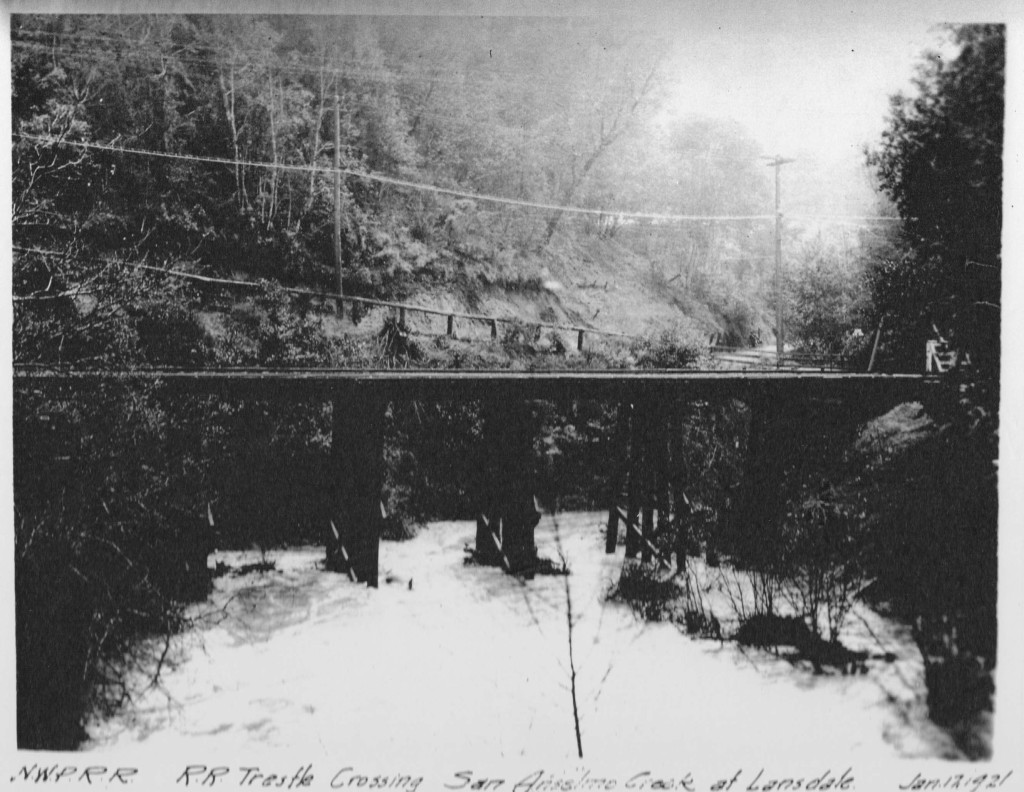
San Anselmo Creek at Lansdale, 1921
February 10-11, 1925.
The worst rain in the history of Marin County reached its peak between sunset February 10th and sunrise on the 11th. More than 7 inches of rain fell in the Ross Valley. Creeks already taxed to carry the rain that had poured down on the county were incapable of carrying the extra water and streets and alleys were inundated.
The first alarm in San Anselmo was sounded by Fire Chief Charles Cartwright who notified merchants within reach that the water was rising. Mad scrambles for dry spots to pile merchandise followed. There was more than 3 feet of water opposite Town Hall. It was feared that the foundations of the Cheda Building and other buildings along the creek would give way. Ladders were used to get occupants from the second floor of the Cheda Building.
According to an engineering report, the extensive damage in San Anselmo, Ross and Kentfield was due to the heavy backup of water against the bridge at Bridge Avenue, where a heavy growth of trees and shrubs had accumulated along the creek for several years. Homes along Sycamore suffered greatly. The water found release when it cascaded over the railroad right of way and flooded San Anselmo, Tamalpais and San Rafael Avenues.
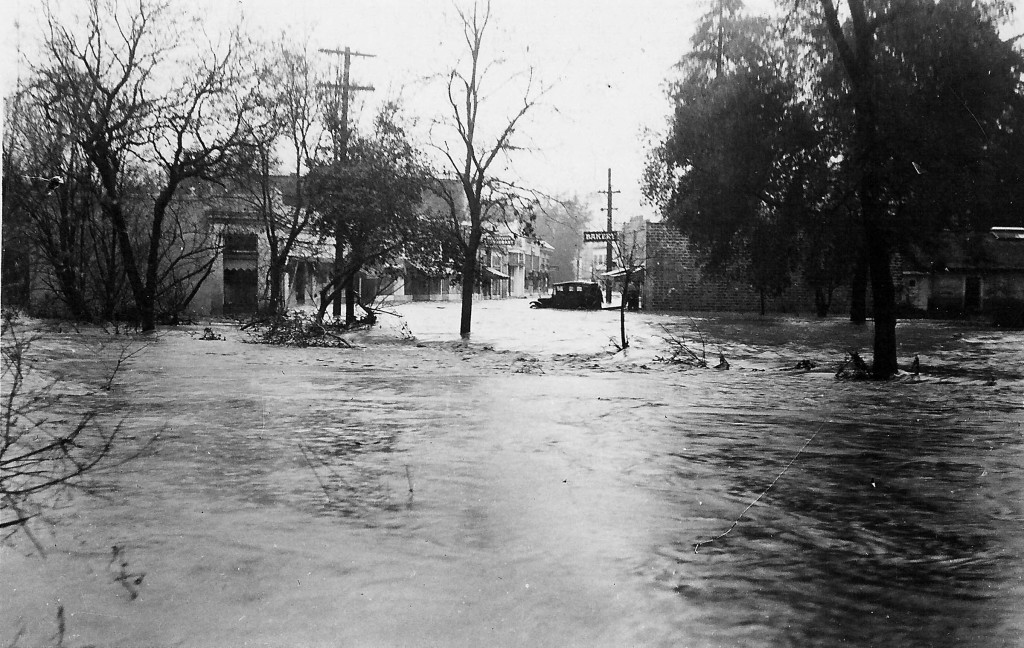
San Anselmo Avenue, 1925 flood.
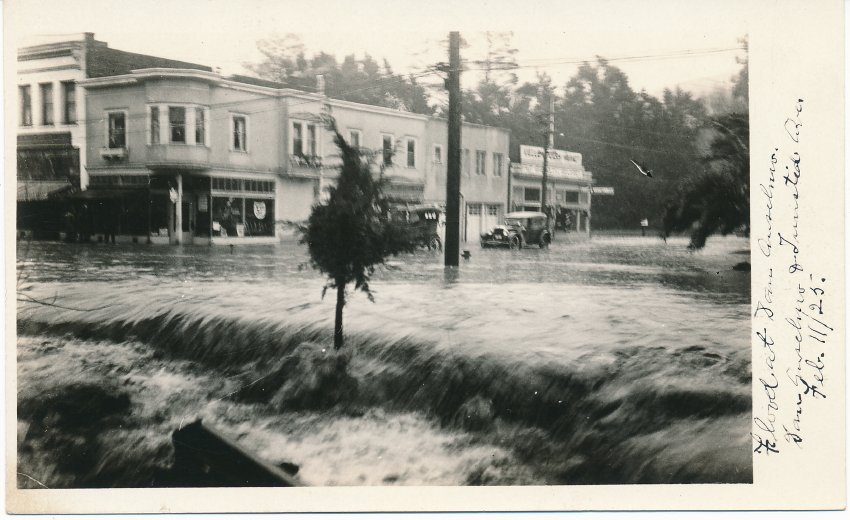
San Anselmo Avenue at Tunstead, 1925
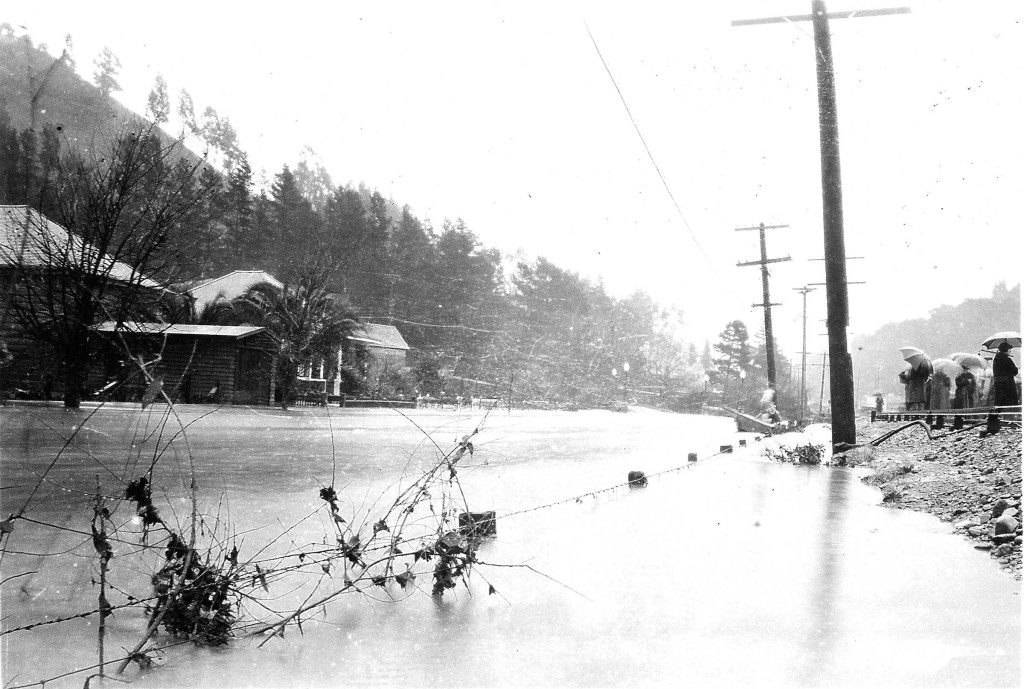
The North Pacific Coast Railroad constructed a berm four to five feet above the valley floor and laid the tracks west from San Anselmo on it. This photograph shows flooded Sycamore Avenue on the left with a crowd gathered trackside during the 1925 flood.
In December 1931, the creek came within three inches of overflowing its banks and flooding the downtown businesses. Credit was given to Police Chief Don Wood who had put San Anselmo men unemployed by the Depression to work cleaning the underbrush, fallen trees and other debris from the San Anselmo, Sleepy Hollow and Sorich Creeks in the preceding months.
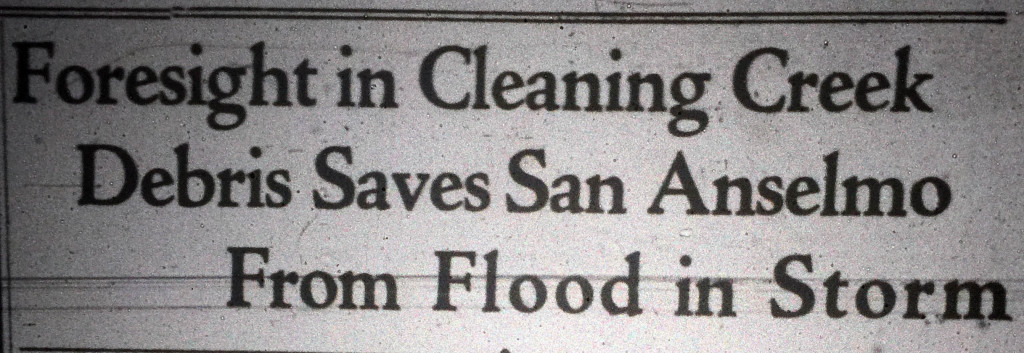
February 26-27, 1940
The San Anselmo Herald reported on February 29, 1940: “A phenomenal rainfall brought San Anselmo Creek up to its highest since 1925 Monday evening with a high tide in sight. Chief Nello Marcucci of the fire department kept close tab on the rising waters. When they steadily rose, he had the street department bring loads of sand. This the firemen sacked, piling the sacks before the doors of business houses on San Anselmo and Tunstead avenues. At midnight the waters of the creek rose so high that they went above the lower level of the service station on San Anselmo Avenue opposite the corner of Tamalpais and San Anselmo. Things moved rapidly after that. The waters began careening off the service station foundations into San Anselmo avenue. They rapidly filled up San Anselmo avenue from curb to curb. They crept towards the doors of business houses, where in most instances they were stopped by the sandbags. But not everywhere…But fortunately the loss was confined to one block on San Anselmo avenue, as the water took a swirl around the corner east on Tunstead and back into the creek.
The San Anselmo Public Library had to be pumped out by firemen. There was three feet of water in the basement, but the damage was small.
Many citizens claim that the oil station on San Anselmo avenue at Tamalpais was allowed to sink its concrete foundations too low. The station entirely spans the creek.”
On January 20, 1943, nine inches fell in a 24 hour period, and the creek went over its banks at Bridge Street on the afternoon of the 21st flooding the downtown business district. There was a raging torrent one to two feet deep along San Anselmo Avenue and water neared the floor level of town hall. Merchants removed sandbags, placed around the library at the beginning of WWII as bomb protection, and used them to block flood waters from entering their places of business. Where sandbags were placed, the water was prevented from entering. In cases where bags couldn’t be obtained in time, the buildings flooded. San Anselmo Bakery suffered heavy losses when a shipment of flour and sugar couldn’t be moved in time. Homes in the Nokomis Avenue area were flooded and Sycamore Avenue was closed.
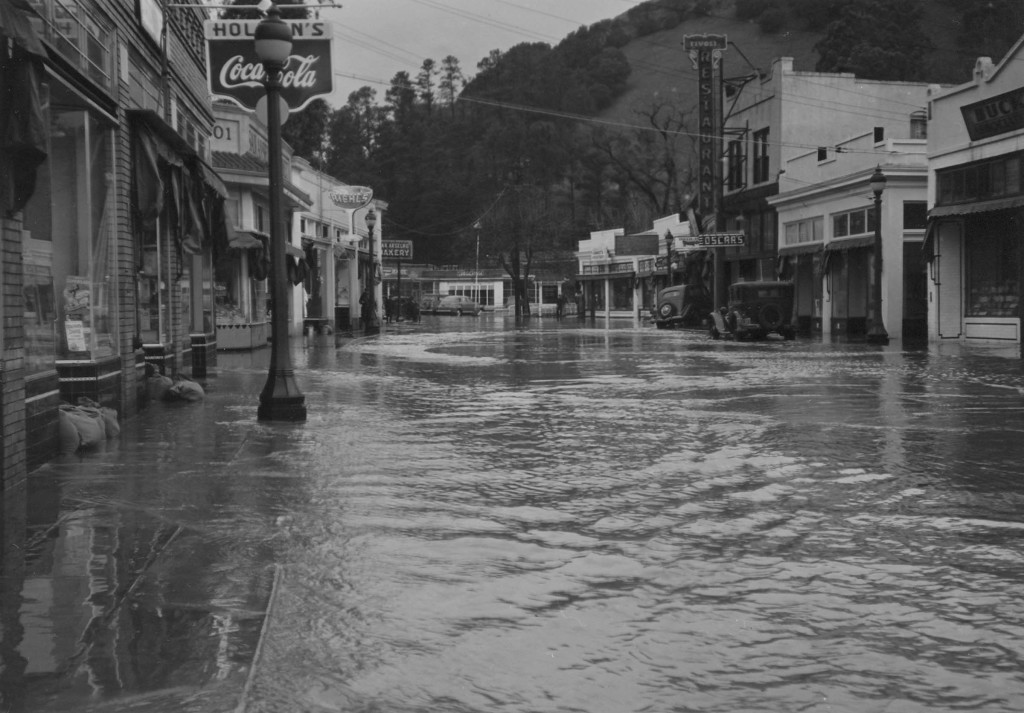
San Anselmo Avenue, January 21, 1943
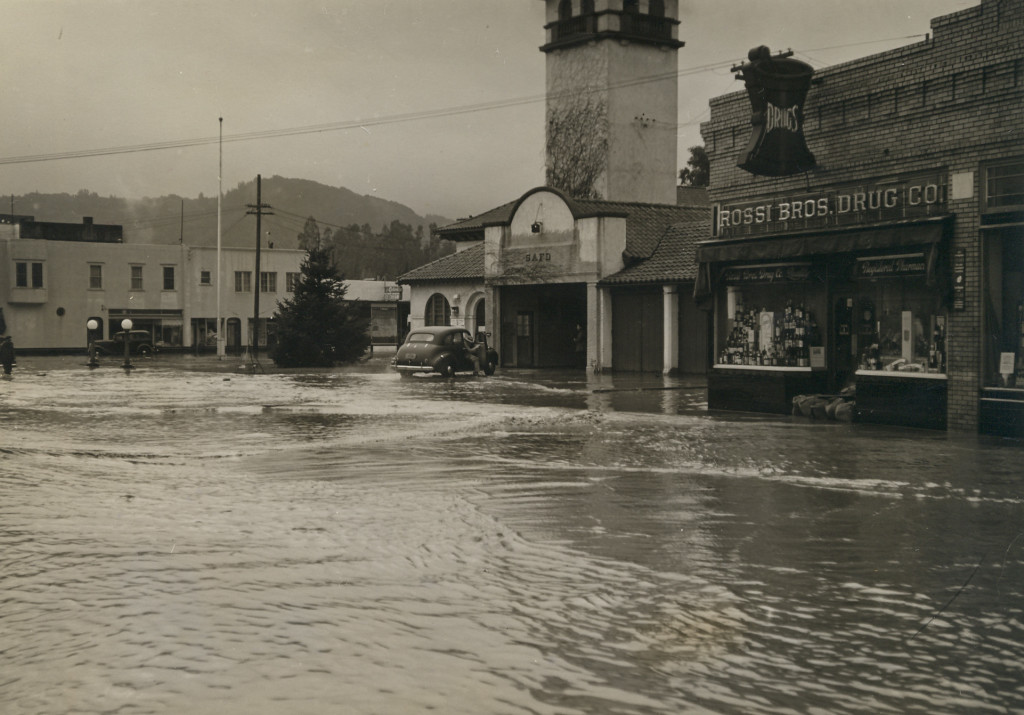
Town Hall and Fire Department, January 21, 1943

San Anselmo Avenue between Belle and Bolinas, January 21, 1943
December 18-21, 1955. The biggest storm to hit San Anselmo after the 1925 flood occurred over a 4 day period in December 1955. Rampaging winds and 16.5 inches of rain created havoc throughout Ross Valley and the rest of the county. San Anselmo was partially isolated as the San Anselmo Avenue business district and Sir Francis Drake from the Hub to Bolinas Avenue were barricaded. Sandbags were piled against merchant’s doorways on the 19th when high water swished into the stores. The water subsided late in the afternoon but left San Anselmo, hit hard by the gales of wind, in a “mess.” The San Anselmo Library basement was flooded and one half of the books in the Children’s Library there were ruined.
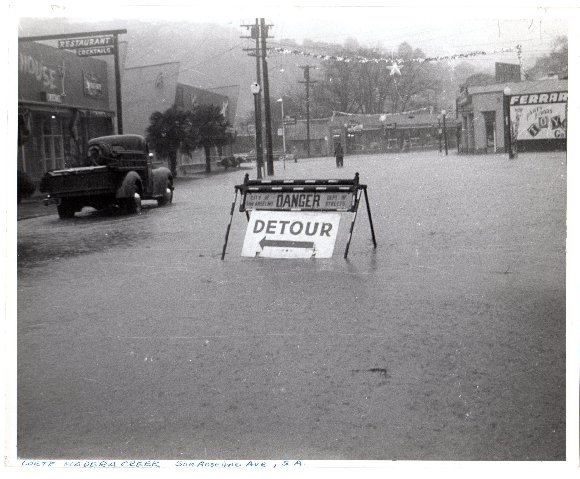
San Anselmo Avenue, December 1955
December 20, 1969. Battered by two big storms, San Anselmo Creek started rising at 4:30 a.m. and by 6:00 a.m. stores in the 600 and 700 block of San Anselmo Avenue were flooded. Police failed to put up barricades to block traffic and passing cars sent waves into doorways which were otherwise above the waterline. Numerous basements in various parts of town also flooded.
January 4, 1982. In the last two weeks of December 1981 more than 10 inches of rain fell. On January 3rd, 7.15 inches fell and another 6.6 inches on the 4th. By noon, San Anselmo Creek had overflowed its banks. The Marin Independent Journal reported: “It was the day the Creek jumped its banks and carved a new course through downtown San Anselmo. A river five feet deep roared down San Anselmo Avenue, consuming cars, flooding businesses and providing daredevils with a once-in-a-lifetime kayaking experience. As water rose inside businesses along the avenue, windows began to explode, spilling goods into the torrent. San Anselmo Avenue was awash with yarn, bottles of vitamins, honey, toys. Damage to downtown businesses was put at more than $4 million.”
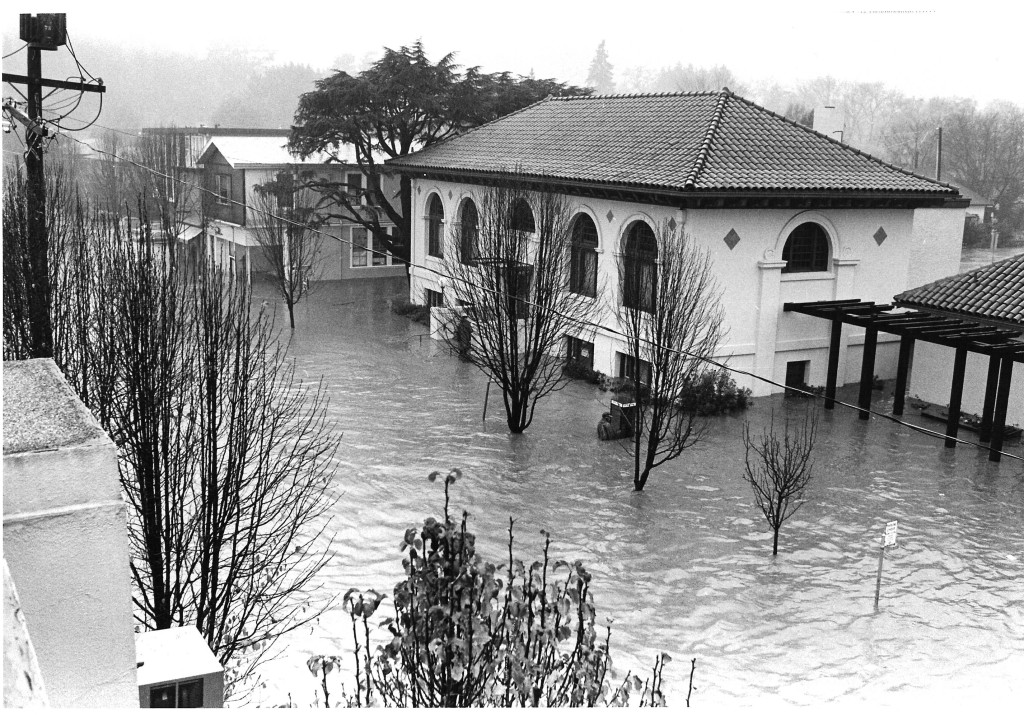
The flood severely damaged the San Anselmo Library. There was five feet of water and mud in the basement, and over 1,000 books were destroyed.
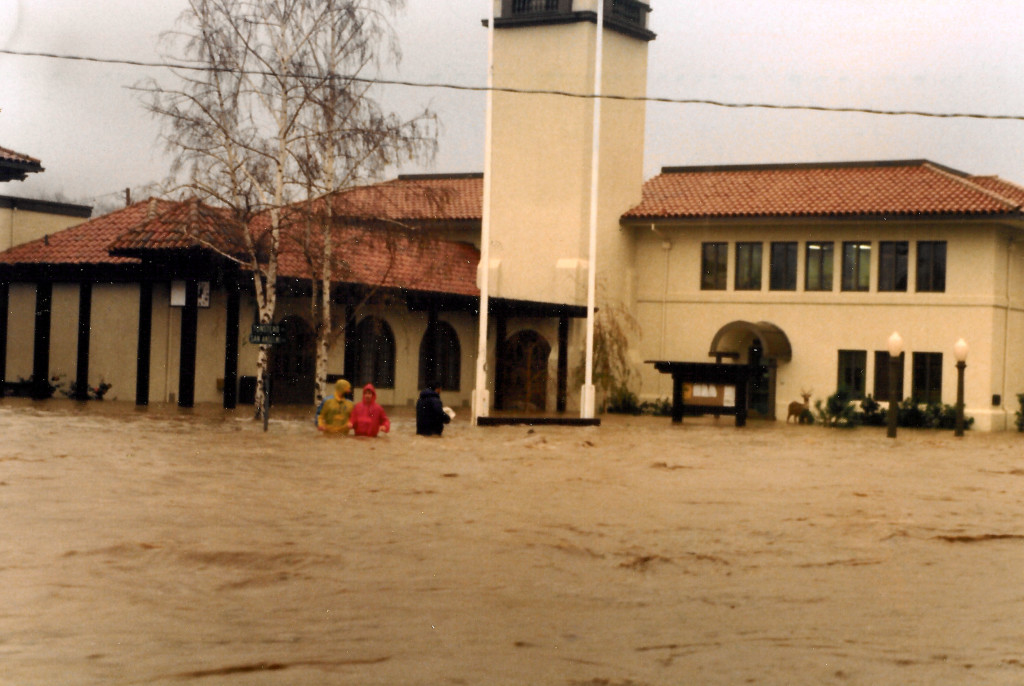
January 4, 1982
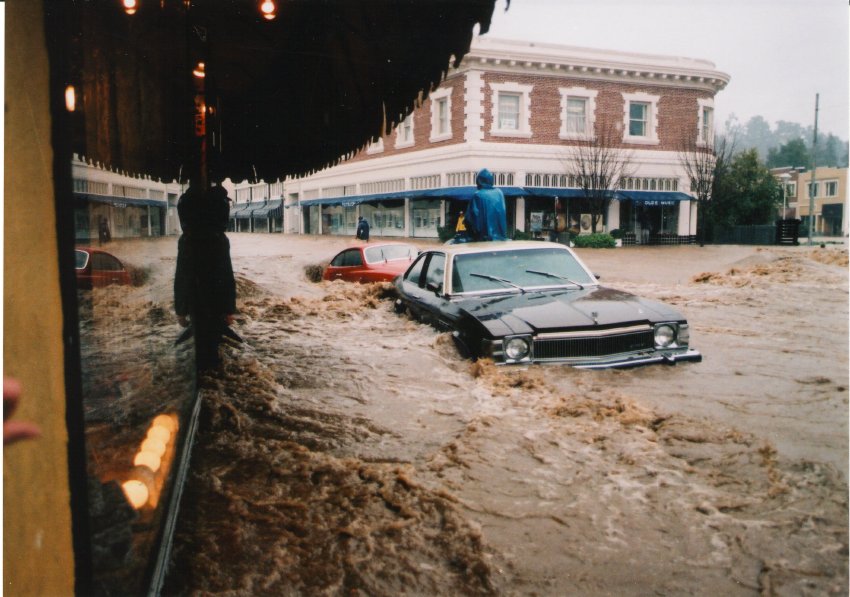
January 4, 1982
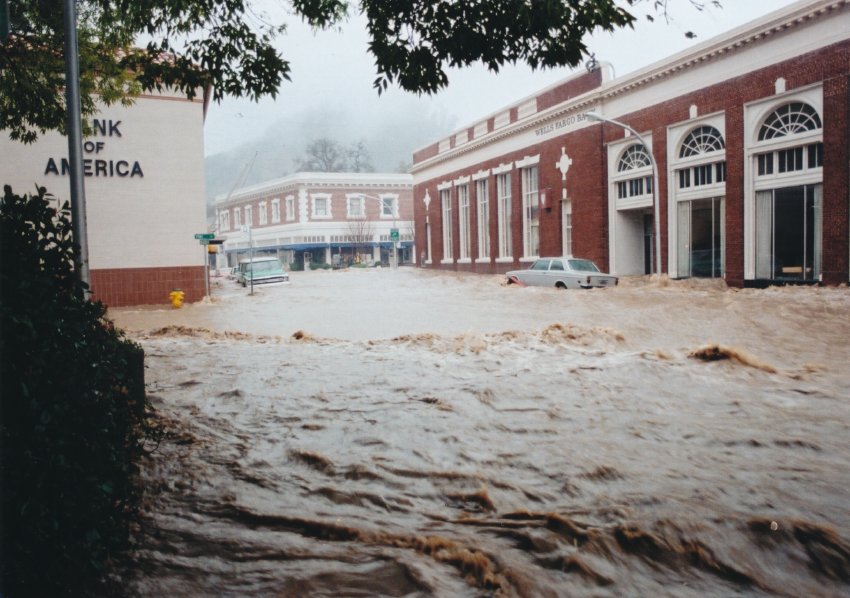
January 4, 1982
December 31, 2005. December 2005 was the wettest December in 50 years after a deluge on the 30th from a “Pineapple Express.” San Anselmo Creek overflowed its banks in the darkness of the early morning hours of December 31st. Town facilities – the library, police department, council chambers, and fire department – were damaged, as well as 140 businesses and 290 homes.
The Independent Journal reported on January 1, 2006 “More than four feet of water rushed like a river down San Anselmo Avenue, scattering cars randomly along sidewalks, flooding the Ross Valley Fire Station headquarters and turning the Town Hall lawn into a mud bog.” Water blew out windows panes and all businesses along San Anselmo Avenue had major damage. Damage was estimated at $30 million. The San Anselmo Library lost about 1,000 books in the basement flooded with three feet of water.
Video footage of the flood can be seen on YouTube here and here.
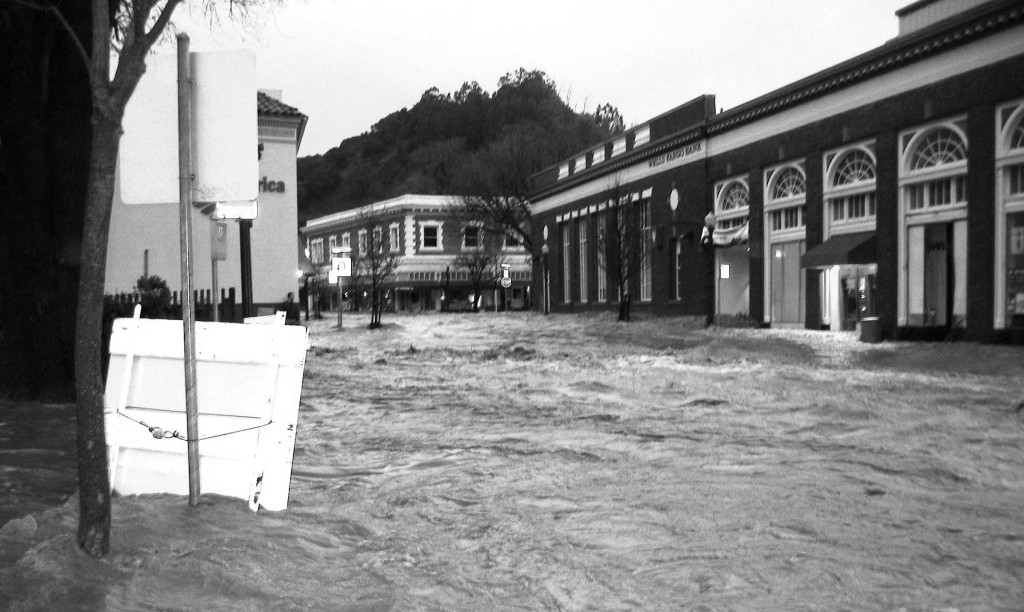
San Anselmo Avenue, early morning 12/31/2005
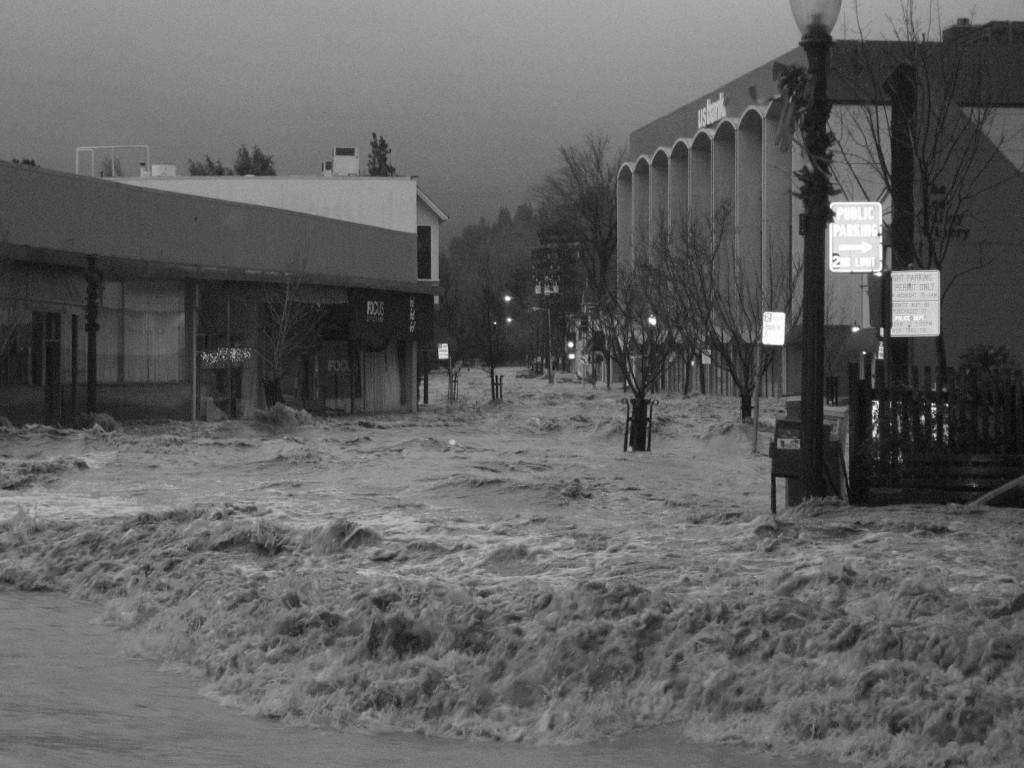
San Anselmo Avenue, early morning 12/31/2005
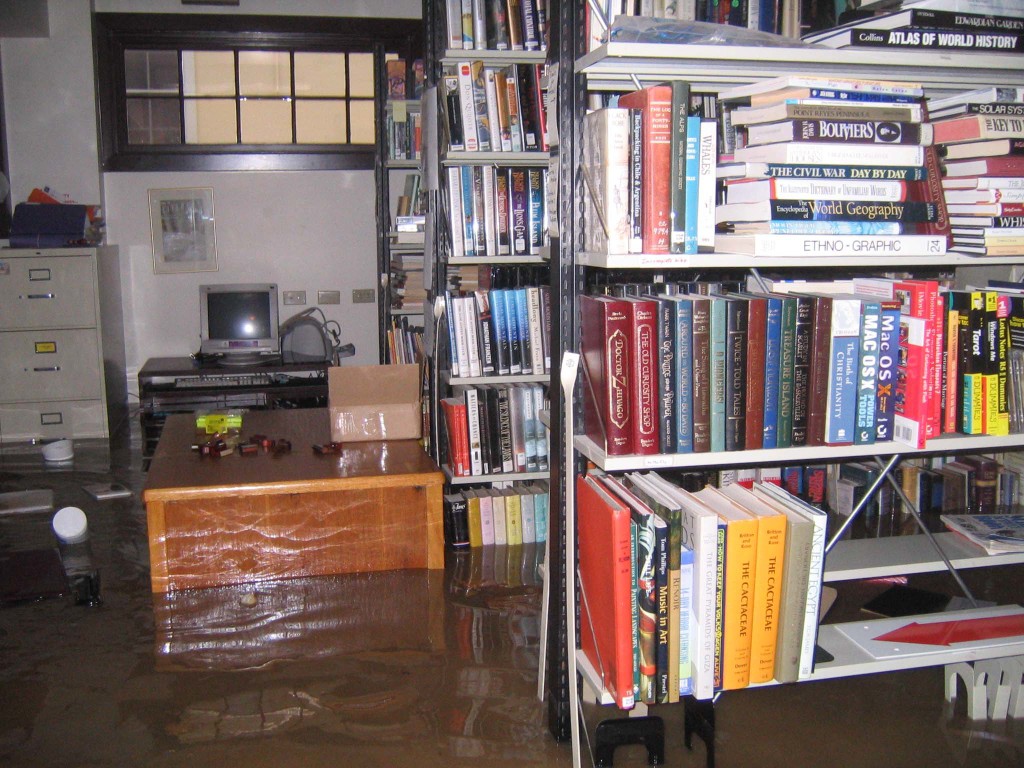
Library Basement, 12/31/2005
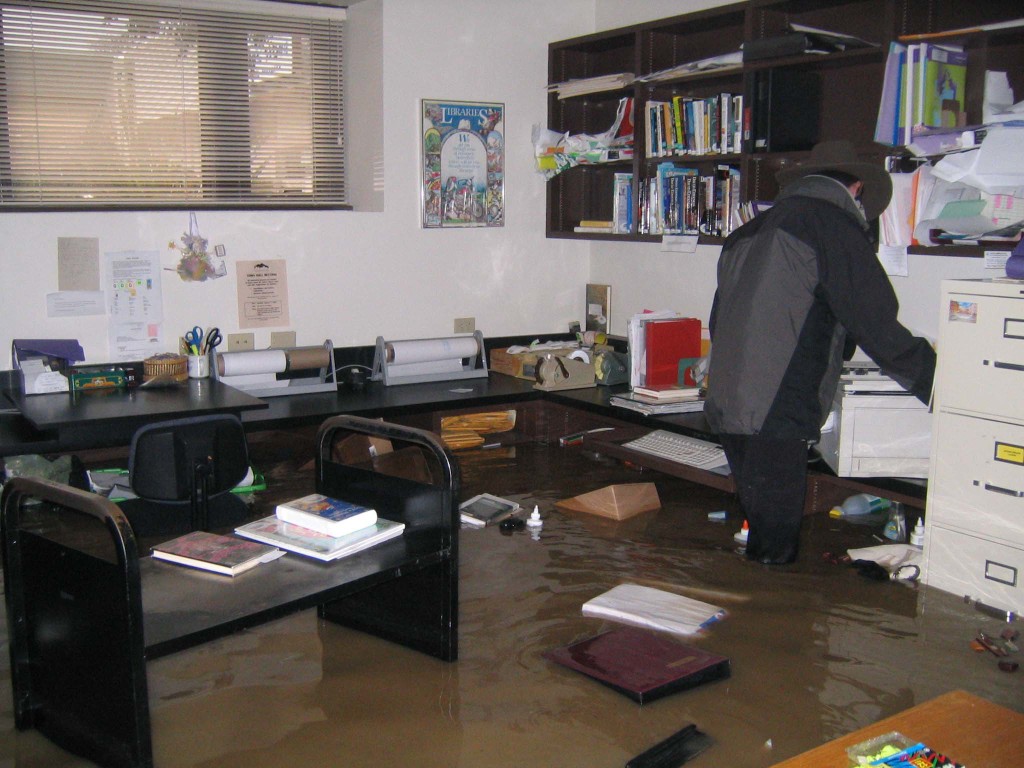
Library Basement, 12/31/2005
Judy Coy
San Anselmo Historical Museum
February 2015

